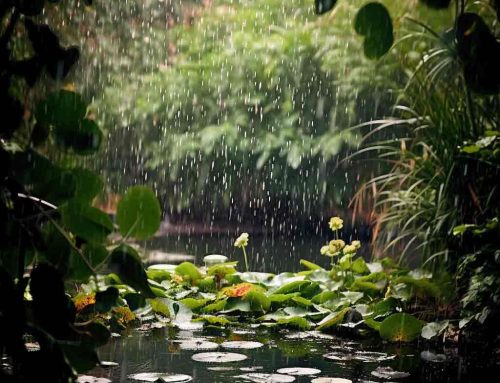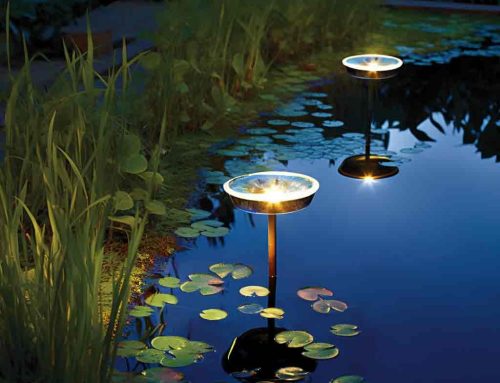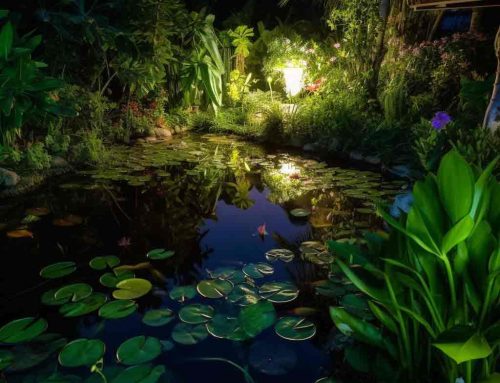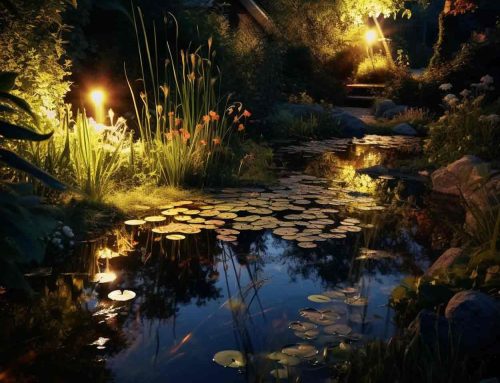
Although concrete is now less commonly used to build ponds than it once was and certainly makes more demands on the builder than the alternatives, it does have some definite advantages which still make it a material worth considering. Particularly when it comes to some kinds of more specialist water features – especially those needing vertical walls such as traditional formal or koi ponds – there is not much to match the strength and rigidity of concrete.
Building a concrete pond
In the days when concrete was used extensively for pond construction, the standard method involved pouring the mix into a mould made with wooden shuttering. While this method allows for irregular shapes to be created, the concrete is prone to cracking and the rise of much cheaper liners and pre-formed ponds has almost entirely superseded this approach for “natural-look” water features. Most of today’s concrete ponds are built using breeze blocks, which are then skimmed with a sharp sand/cement/fibre glass mix.
Starting the Construction of concrete pond
The construction process for this type of pond is relatively straight-forward, if somewhat time-consuming. The first step is to dig out the hole to the required size; since most concrete ponds are square or rectangular, it is worth taking the time to mark out the outline making sure that the angles are true, the lines are straight and the walls as near upright as possible. Getting this right at the outset can save a lot of time and frustration in the long run since as the digging progresses, it can be surprisingly easy to drift off course. You should aim to go down around 5 – 6 inches (12 – 15cm) below the finished pond’s intended depth, to allow for the base.
Excavating your pond
Once the excavation for the actual body of the pond is complete, you’ll need to dig a trench for the foundations – about 4 inches (10cm) deep and 8 inches across (20cm) – around the outside of the hole to support the block-work. Once this has been completed, it needs to be filled with concrete and then allowed to dry thoroughly.
Next, the soil at the base of the hole should be raked level, a layer of sand added and then tamped down firmly to compact it well, making sure that it finishes level with the foundations. Lay a 3inch (7.5cm) coat of concrete over the whole area and allow it to dry completely, before adding galvanised mesh for reinforcement and then finish off with a second 3inch (7.5cm) layer of concrete. Make sure it has dried out thoroughly before continuing. The whole base now needs to be skimmed with a half-inch (12mm) coat of cement containing reinforcing fibres. The purpose-made reinforcement fibres are designed to help prevent small cracks from appearing and makes the whole structure less likely to leak; they can be bought from most builders’ merchants and specialist water garden suppliers.
After 24 hours, once the cement base has had a chance to dry, the next step is to build the block-work walls, filling both the hollows in the blocks themselves and any gaps between them and the surrounding soil with concrete. A course or two of house bricks at the top of the block wall finishes the whole thing off neatly, providing a level edging for the pond.
Finishing Off Your concrete pond
The walls need to be left to dry for at least another 48 hours, after which time they can be dampened slightly and then skimmed with a half-inch (12mm) layer of fibre-reinforced cement to match the base. The final part of the real construction work calls for an edging layer of bricks or slabs to be mortared into place around the top of the wall, allowing an over-hang of a good 2 or 3 inches (5 or 7.5cm).
After a further 48 hours, the last step is to paint the inside of the structure with a good quality waterproof sealant – principally to stop the lime in the cement from leaching out into the water and causing problems for the plants and pond-life. Wait a few more days and then fill the pond. It is always a good idea to check the pH of the water in a concrete pond to make sure it is around neutral – pH7 – before you start planting up or introducing any fish; if the pH is much higher than this, the conditions will be too alkaline for pond-life to thrive. If this does occur, it doesn’t automatically mean that your attempts at sealing the concrete have failed, so it is worth waiting a few more days and testing again as the problem can sometimes be a short-lived one.
Advantages of a concrete pond
Building a concrete pond is undoubtedly a far larger undertaking than making one with any of the more common types of liner, but for some types of pond, it remains the best material for the job. Although they take longer to complete and require much more in the way of effort, if you take your time and proceed carefully, a very durable and good-looking pond can be yours.
Concrete Ponds FAQ
Is a concrete pond good?
Concrete ponds can be a good choice for those looking for a permanent water feature. They have smooth walls and are easy to clean, making them a great choice for keeping fish. However, the quality of the pond will depend on its design and construction. Properly designed and built concrete ponds can be a beautiful addition to any backyard or garden, but poorly designed and constructed ponds can be a nightmare. It is essential to hire a professional with experience in building concrete ponds to ensure the best possible outcome.
Can fish live in a concrete pond?
Yes, fish can live in a concrete pond. However, before adding fish, the pond must be cured to make it safe for them. Curing involves filling the newly constructed pond with water and allowing it to sit for a week before draining and refilling it. After two weeks, the pond should be drained and refilled again. This process allows the pond to release any toxins and be made safe for fish.
Do concrete ponds leak?
Although concrete ponds are strong and permanent, they can sometimes develop leaks due to settling, tree roots, or damage. The good news is that repairing leaks in concrete ponds is easy, and it is not necessary to drain the pond. Repairs can be done using a variety of materials such as epoxy, hydraulic cement, or polyurethane.
How thick is a concrete pond?
The recommended thickness for a concrete pond is 4 to 6 inches. Once the pond’s dimensions are established, the soil is dug out, and forms are built to hold the concrete while it dries and cures. After the concrete has cured, the forms can be removed, and the pond can be filled with water. It is important to note that the thickness of the concrete will depend on the size and shape of the pond, as well as the amount of water it will hold.
How do you treat concrete pond water?
Newly cemented ponds release quantities of free lime into the water, which can be toxic to fish and plants. To cure a concrete pond, mix one gallon of household vinegar with each 200 gallons of water in the pond and let it sit for three days. After three days, empty the pond and rinse it thoroughly. This process will remove any toxins and make the water safe for fish and plants. It is important to note that the curing process should be done before adding fish or plants to the pond.
What are the disadvantages of concrete pond?
While concrete ponds have many advantages, such as durability and ease of cleaning, there are some disadvantages to consider. One of the main drawbacks of concrete fish ponds is that they can be slippery due to fish waste and algae growth. This can be dangerous for fish farmers and could cause harm. Harvesting fish from concrete ponds is generally faster than from earthen ponds, but the risk of slips and falls can be a concern. Additionally, concrete ponds can be more expensive to construct than other types of ponds, and they may require more maintenance in the long run.
Will a concrete pond leak?
Although concrete ponds are known for their durability, they are not completely immune to leaks. Even with proper construction and maintenance, any container holding water can leak. Common causes of leaks in concrete ponds include settling, tree roots, and damage to the pond. Fortunately, leaks in concrete ponds can be repaired without draining the pond. It is important to identify the source of the leak and use appropriate repair materials.
How do you waterproof a concrete pond?
Waterproofing a concrete pond involves several steps to ensure the pond is properly sealed. First, the pond should be cleaned thoroughly and allowed to dry. Next, Liquid Rubber can be applied to all areas needing extra reinforcement, such as penetrations and joins. Three coats of Liquid Rubber should then be applied, allowing each coat to cure for approximately 24 hours. The final membrane should be allowed to cure for a minimum of three weeks before filling the pond with water. This process will ensure the pond is properly waterproofed and prevent any leaks.
What are the biggest problems with concrete?
Concrete is a popular building material due to its strength and durability, but it is not without its problems. Some common issues with concrete include construction errors, disintegration and scaling, cracks, efflorescence, erosion, spalling, and popouts. Construction errors can lead to problems such as uneven surfaces or inadequate reinforcement, while disintegration and scaling can occur due to exposure to weather or chemicals. Cracks can develop due to various factors such as improper curing, while efflorescence occurs when salts migrate to the surface of the concrete. Erosion can be caused by water or wind, while spalling and popouts are caused by freeze-thaw cycles.
How long does it take for concrete pond to cure?
Curing is an important process that allows the chemical reaction between cement and water to bind sand and gravel together to make concrete. This process takes nearly 28 days to complete fully. During this time, it is essential to keep the concrete moist to prevent it from cracking. However, it is possible to walk on the concrete after about 24-48 hours. After the concrete has cured, it will be strong and durable, making it ideal for use in a variety of applications, including fish ponds.
How long does a concrete pond last?
The lifespan of a concrete pond largely depends on how well it is constructed and maintained. If properly constructed and maintained, a concrete pond can last a lifetime. However, it is essential to ensure that the pond is built with high-quality materials and that it is installed correctly. Vertical walls can also be used to increase the ratio of gallonage to surface area, making the pond more efficient. Although concrete ponds are generally more expensive than other types of ponds, they are a durable and long-lasting option for fish farming.
What are the characteristics of concrete pond?
A well-designed concrete pond should have a reliable water supply and proper drainage. This means that the pond floor should have a slight slope (0.5%) from the water inlet to the drainage point. The drainage outlet (standpipe or monk) must be designed with care to ensure proper water flow. Water inlet and outlet should be at opposite ends of the pond to facilitate water exchange within the pond. Additionally, concrete ponds can be classified into three different types: stagnant concrete ponds, free flow concrete ponds, and water re-circulatory concrete ponds. Each type has its own unique characteristics and uses.
What is the explanation of concrete pond?
A concrete pond is a type of fish pond constructed using cement, blocks, and aggregates of suitable ratios. Concrete ponds can be classified into three different types based on their design and functionality. Stagnant concrete ponds are designed for simple water storage and fish farming. Free flow concrete ponds are designed for water exchange and are more efficient for raising fish. Water re-circulatory concrete ponds are designed to conserve water and recirculate it within the pond. Concrete ponds are a popular choice for fish farming due to their durability and ease of management. They can be constructed on dry land and have a manageable surface area, making them a great choice for aquaculture.
Last Modified: April 5, 2023









I am in the process of re-lining my pond with PVC liner. I have cemented house bricks around the edge and in doing so, pieces of cement fall into the base and stain the sides and floor. I will remove all the hard pieces and wash the base and walls, but this will always leave a smear of concrete on the sides and floor. Is there a risk to fish (Koi) or is some treatment required to neutralise any traces of the cement? Your respopnse would be appreciated Thank you David.
Question i have what was originally a raised flower bed, solidly built and converted to a pond with a flexible liner to a pond. I would like to convert this to a pond with concrete base and render the walls and finally a painted surface. I was thinking putting re reinforcements in the base and running these up the walls approx 6″ so once rendered it would be all one. don’t really want to knock it all down and start again do you this this is feasible? or would it be better to stick with a liner??
Very useful information, thanks. I have dug out a rectangle for a concrete pond 4m x 3m. Can you tell me what ration concrete mix to do? Is it best to use ballast or sharp sand for the concrete base? Thanks
Hi I’m wanting to build a pond on top of an already established 4” concrete base using breeze blocks and rubber liner. Can this be done? Thankyou
Hi, I really appreciate the info provided here. I just got a job to manage an integrated farm. I am an Agricultural and Environmental Engineer. A pond for catfish was part of the farm plan, in addition to poultry, vegetable garden, dog pens, brooding house etc, of all, I have never built a concrete pond for any one yet in the past. I consider the information here really helpful. Thanks. Engr. Ahiaba V.U
@David. It’s probably an insufficient enough amount that it won’t even matter, but I’d use a neutraliser if you want to be 100% sure.
What size concrete blocks do i need for a koi pond walls. Apprx 5th x 8ft x 3 ft deep. Apprx fist 1ft will be beliw ground.
Nice info,can 10 by 10 carry upto 1000-1200 fish
What paint do I need to put on the concrete to seal the wall and the base please Peter
Hi Read this with interest. I have built two ponds (one flows into the other) from 220 x440 breeze blocks. Can you tell me what amount of render to use on the sides ? The ponds are around 600mm deep. Thanks
Hi, I’m in the middle of building a pond, I have nearly dug all I need to. I have some house bricks, can I place them in the sides & base of pond the put galvanised wire mesh on top then concrete? Thanks
I have wanting too create a geometric formed pond over a hillsidea slope. If anybody has some idea as to how to do it effectively
I really appreciate the info, it was useful.. Please how many fishes can a concrete pond of 15 by 12 and 4 depth can take